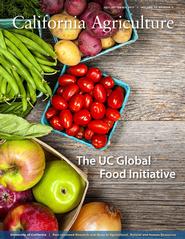Calag Archive
Calag Archive

Editor Jim Downing talks about what's in the current issue of California Agriculture journal — mapping soil salinity by satellite; evaluating crop ownership patterns in California; growing oilseeds in winter without irrigation; seeding rangelands; keeping dairy cows cool; and pedagogical lessons for volunteer educators.
Volume 71, Number 3


